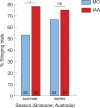Division of labour during honeybee colony defence: poetic and scientific views
- PMID: 40109103
- PMCID: PMC11923620
- DOI: 10.1098/rstb.2023.0272
Division of labour during honeybee colony defence: poetic and scientific views
Abstract
Poets, philosophers and politicians have used bees, and often projected an idealized human society into their view of how beehives are organized, from the ancient Greeks to present times. We first review how division of labour in honeybees was perceived by human observers, before presenting our current understanding. We focus specifically on defensive behaviour and show that this model provides an interesting case study for our conceptual understanding of division of labour as a whole. We distinguish three phases of the defensive response: detection of an intruder, recruitment of individuals into collective defence and attack. Individual bees may selectively contribute to one or more of these steps. Guard bees monitor entering conspecifics or attacking mammals, and release an alarm pheromone to recruit stinging soldiers. However, we are still far from understanding why only subsets of bees become guards or soldiers (or even if soldiering can be considered a task per se). We discuss the stimuli associated with each of these steps, how they define the number of bees needed and how they might combine with individual and developmental characteristics such that individuals take on a particular task. We also highlight pending questions and interesting avenues for future research.This article is part of the theme issue 'Division of labour as key driver of social evolution'.
Keywords: defence; guard bees; honeybee; soldier bees.
Conflict of interest statement
We declare we have no competing interests.
Figures



Similar articles
-
Extracting individual characteristics from population data reveals a negative social effect during honeybee defence.PLoS Comput Biol. 2022 Sep 15;18(9):e1010305. doi: 10.1371/journal.pcbi.1010305. eCollection 2022 Sep. PLoS Comput Biol. 2022. PMID: 36107824 Free PMC article.
-
The defensive response of the honeybee Apis mellifera.J Exp Biol. 2016 Nov 15;219(Pt 22):3505-3517. doi: 10.1242/jeb.143016. J Exp Biol. 2016. PMID: 27852760 Review.
-
Honeybee communication during collective defence is shaped by predation.BMC Biol. 2021 May 25;19(1):106. doi: 10.1186/s12915-021-01028-x. BMC Biol. 2021. PMID: 34030690 Free PMC article.
-
Seasonality, alarm pheromone and serotonin: insights on the neurobiology of honeybee defence from winter bees.Biol Lett. 2018 Aug;14(8):20180337. doi: 10.1098/rsbl.2018.0337. Biol Lett. 2018. PMID: 30158140 Free PMC article.
-
Defensive behavior of honey bees: organization, genetics, and comparisons with other bees.Annu Rev Entomol. 2004;49:271-98. doi: 10.1146/annurev.ento.49.061802.123155. Annu Rev Entomol. 2004. PMID: 14651465 Review.
Cited by
-
Division of labour as key driver of social evolution.Philos Trans R Soc Lond B Biol Sci. 2025 Mar 20;380(1922):20230261. doi: 10.1098/rstb.2023.0261. Epub 2025 Mar 20. Philos Trans R Soc Lond B Biol Sci. 2025. PMID: 40109104 Free PMC article. Review.
-
The Pheromone Landscape of Apis mellifera: Caste-Determined Chemical Signals and Their Influence on Social Dynamics.Molecules. 2025 May 29;30(11):2369. doi: 10.3390/molecules30112369. Molecules. 2025. PMID: 40509256 Free PMC article. Review.
References
-
- Kindt J. 2020. Animals in ancient Greek religion. Abingdon, UK: Routledge. (10.4324/9780429424304) - DOI
-
- Shakespeare W. 2008. Henry V. Oxford, UK: Oxford University Press.
-
- Johach E. 2020. Wilde soziologie: soziale insekten und die phantasmen moderner vergesellschaftung. Paderborn, Germany: Brill.
-
- Johach E. 2009. Weiblicher Urgrund des Sozialen: Zur Bio-Politik des Unbewussten in Ernst Bergmanns ’Erkenntnisgeist und Muttergeist’ (1932). In Das unbewusste: krisis und kapital der wissenschaften: studien zum verhältnis von wissen und geschlecht (eds von Braun C, Dornhof D, Johach E), pp. 264–280. Bielefeld, Germany: transcript. (10.1515/9783839411452-014) - DOI
-
- Seeley TD. 2010. Honeybee democracy. Princeton, NJ: Princeton University Press.
Publication types
MeSH terms
Grants and funding
LinkOut - more resources
Full Text Sources

